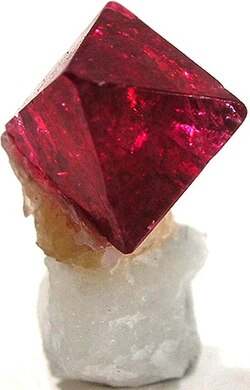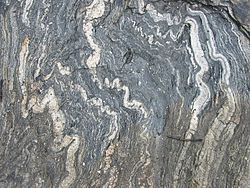Metamorphic rock
A metamorphic rock is a type of rock which has been changed by extreme heat and pressure. Its name is from 'morph' (meaning form), and 'meta' (meaning change).[1]



The original rock gets heated (temperatures greater than 150 to 200 °C) and pressured (1500 bars).[2] This causes profound physical and/or chemical change. The original rock may be sedimentary rock, igneous rock or another older metamorphic rock.
There is always more pressure and higher temperature under the Earth's surface. In the root of a mountain chain or a volcano these forces will be enough to change shape of the strata and the minerals it is made of. Sedimentary rock which has been near such forces often looks as if a giant had twisted it and heated it over a fire. Examples of metamorphic rock:
- Marble is a metamorphic rock formed from limestone.
- Slate is a metamorphic mudstone or shale.
- Quartzite is a metamorphic sandstone.
The recrystallisation of minerals after heating generally causes the destruction of any fossils the rocks might have contained. These rocks are formed when igneous or sedimentary rocks are subjected to extreme heat and pressure. As a result, they undergo a complete change in their form and characteristics. Rocks who have been changed in this way are called metamorphic rocks.
Types of metamorphism
changeRegional metamorphism
changeRegional metamorphism, or dynamic metamorphism, occurs in great masses of rock. Rocks can be metamorphosed just by being at great depths below the Earth's surface. There they get high temperatures and the great weight of the rock layers above.
Much of the lower continental crust is metamorphic, except for recent igneous intrusions. Horizontal tectonic movements such as the collision of continents create orogenic belts. High temperature, pressures and deformation occurs along these belts. If the metamorphosed rocks are later uplifted and exposed by erosion, they are seen as long belts or other large areas at the surface.
Contact metamorphism
changeContact metamorphism occurs when magma is injected into the surrounding solid rock (country rock). The changes that occur are greatest where the magma comes into contact with the rock. The temperatures were highest there and decreased with distance from it.
Metamorphic minerals
changeEvery mineral is stable only within certain limits. When certain minerals appear in metamorphic rocks this shows the approximate temperatures and pressures the rock experienced. These minerals are known as index minerals. Sillimanite, kyanite, staurolite, andalusite, and some garnet are examples.
Other minerals, such as olivines, pyroxenes, amphiboles, micas, feldspars, and quartz may be found in metamorphic rocks. These minerals formed during the crystallization of igneous rocks. They are stable at high temperatures and pressures and may remain chemically unchanged during the metamorphic process.
Related pages
changeReferences
changeOther websites
change- Metamorphic textures - Middle East Technical University Archived 2005-03-07 at the Wayback Machine
- Metamorphism - U. of Alabama Archived 2008-06-22 at the Wayback Machine
- Types of metamorphism - Tulane U.
- Contact metamorphism example Archived 2012-02-16 at the Wayback Machine